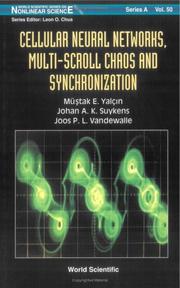| Listing 1 - 3 of 3 |
Sort by
|

ISBN: 1281347868 9786611347864 9812567747 9789812567741 9789812561619 9812561617 Year: 2005 Volume: v. 50 Publisher: New Jersey London World Scientific
Abstract | Keywords | Export | Availability | Bookmark
 Loading...
Loading...Choose an application
- Reference Manager
- EndNote
- RefWorks (Direct export to RefWorks)
For engineering applications that are based on nonlinear phenomena, novel information processing systems require new methodologies and design principles. This perspective is the basis of the three cornerstones of this book: cellular neural networks, chaos and synchronization. Cellular neural networks and their universal machine implementations offer a well-established platform for processing spatial-temporal patterns and wave computing. Multi-scroll circuits are generalizations to the original Chua's circuit, leading to chip implementable circuits with increasingly complex attractors. Several
Neural networks (Computer science) --- Nonlinear systems. --- Chaotic behavior in systems. --- Synchronization. --- Computer engineering. --- Computers --- Synchronism --- Time measurements --- Chaos in systems --- Chaos theory --- Chaotic motion in systems --- Differentiable dynamical systems --- Dynamics --- Nonlinear theories --- System theory --- Systems, Nonlinear --- Artificial neural networks --- Nets, Neural (Computer science) --- Networks, Neural (Computer science) --- Neural nets (Computer science) --- Artificial intelligence --- Natural computation --- Soft computing --- Design and construction --- Neural networks (Computer science).
Book
ISBN: 9783030178406 Year: 2020 Publisher: Cham Springer International Publishing :Imprint: Springer
Abstract | Keywords | Export | Availability | Bookmark
 Loading...
Loading...Choose an application
- Reference Manager
- EndNote
- RefWorks (Direct export to RefWorks)
Multi
ISBN: 9783030178406 Year: 2020 Publisher: Cham Springer International Publishing :Imprint: Springer
Abstract | Keywords | Export | Availability | Bookmark
 Loading...
Loading...Choose an application
- Reference Manager
- EndNote
- RefWorks (Direct export to RefWorks)
This book explores how neural networks can be designed to analyze sensory data in a way that mimics natural systems. It introduces readers to the cellular neural network (CNN) and formulates it to match the behavior of the Wilson–Cowan model. In turn, two properties that are vital in nature are added to the CNN to help it more accurately deliver mimetic behavior: randomness of connection, and the presence of different dynamics (excitatory and inhibitory) within the same network. It uses an ID matrix to determine the location of excitatory and inhibitory neurons, and to reconfigure the network to optimize its topology. The book demonstrates that reconfiguring a single-layer CNN is an easier and more flexible solution than the procedure required in a multilayer CNN, in which excitatory and inhibitory neurons are separate, and that the key CNN criteria of a spatially invariant template and local coupling are fulfilled. In closing, the application of the authors’ neuron population model as a feature extractor is exemplified using odor and electroencephalogram classification.
| Listing 1 - 3 of 3 |
Sort by
|

 Search
Search Feedback
Feedback About UniCat
About UniCat  Help
Help News
News